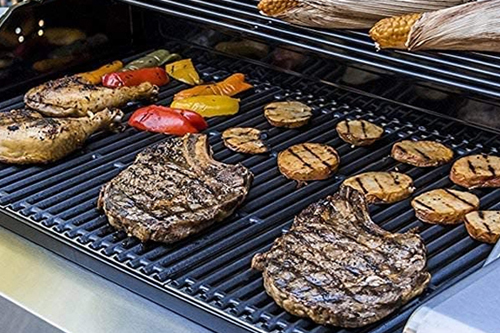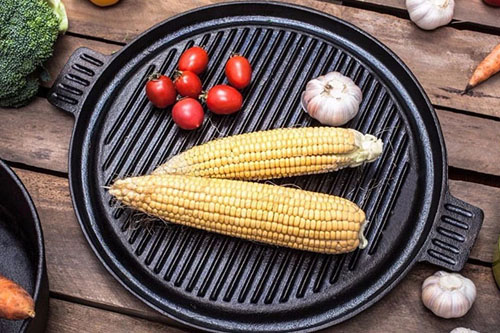Which Is Better Porcelain or Cast Iron Grill Grates?
When choosing a grill, there are many important details to consider. However, one component that can easily be overlooked is the cooking surface of the grill. While you do need to decide on the best heat source for your grill and how the grill will look, it is important to choose a grill surface that cooks your food the way you want it to.
Then you need to determine which type of grill is best for your grilling needs. Strength, durability, materials, and a non-stick surface are all factors to consider when choosing the ideal cooking grate.
In this guide, we will guide you through the different types of grill grates available and how to choose the best grill grate for you.
Cast Iron BBQ Charcoal Roaster Grill Grate
What is a grill grate and what is it used for?
Many grill masters see a grill pan for cooking food and simply refer to it as a "grill". In fact, it's called a grill.
The grill is simply the surface on which you cook your food above the heat source. Grill grates can be made from many different types of material and take different forms.
The grill grate is one of the most important parts of the grill. Not only does it hold the food, but it also helps to transfer heat evenly, prevents food from sticking and even provides beautiful grill marks. Choosing the right grill grate is an important part of your entire grilling experience.
No matter what material your cooking grids are made of, they will eventually wear out and need replacing. Give your grill a new look with a new grid.
Types of barbecue grates - stainless steel, cast iron, and porcelain
Cooking grids are made from a variety of materials. Most cooking grids are made from cast iron, stainless steel, or porcelain. Although you may think that the choice of material is based on aesthetics, the truth is that metals all have unique properties which make them react differently to the surrounding elements. In the case of a grill, the element is extremely hot.
Tip: Manufacturers use different materials to produce the cooking grids that are mounted on the grill. When purchasing replacement grill parts, try using parts made from the same material as the original manufacturer's parts that came with the grill.
The difference between cast iron and stainless steel: the basics
Both cast iron and stainless steel are considered to be alloys of iron. In other words, they consist mainly of iron ore but contain other metals or elements. The main difference between cast iron and stainless steel lies in the specific type and amount of non-ferrous metals or elements used.
Cast iron is an iron alloy characterized by a minimum carbon content of 2%, whereas stainless steel is an iron alloy characterized by a maximum carbon content of 1.2% and a minimum chromium content of 10.5%. Cast iron, therefore, contains more carbon than stainless steel, but stainless steel has a high chromium content, which is not found in cast iron.
Cast Iron Round Grill Pan Griddle Plate
Benefits of using a cast iron grate
Compared to stainless steel cooking grates, cast iron cooking grates have excellent heat retention. Once warmed up, they will retain their heat, allowing you to grill delicious steaks and meats. Stainless steel grates can also retain heat, but their unique composition provides a lower insulation value than cast iron grates.
Assuming you clean and maintain them, cast iron grates can last for years or even decades. They are very robust and most cast iron grates will last even longer than stainless steel grates of the same size. Simply clean the grate each time you use it and it will provide you with countless years of enjoyment.
Food is also less likely to stick to a cast iron grate than to a stainless steel grate. Many cast iron grates are coated with a non-stick coating, which means that your food should not stick to them. Even if a cast iron griddle does not have a non-stick surface, you can create a natural non-stick surface by 'seasoning' it. This does not involve sprinkling salt and pepper on the grates. The term "seasoning" refers to applying multiple layers of oil to a cooking grate to create a non-stick surface. The oil penetrates the semi-porous surface of the grates to create a non-stick surface. If you find that your food starts to stick to the cast iron grate after it has been seasoned, simply repeat the process to 're-season' it.
Porcelain Grate
Porcelain-coated steel is a good choice, but the coating does have a nasty habit of flaking off. This can expose the metal underneath to moisture and can lead to surface rusting over time. This is particularly true of coated cast iron, although coated steel can also present problems.
This is not to say that porcelain coatings are all bad. Choosing a quality porcelain grate is usually a simple matter. While the price tag may be tempting, a cheap porcelain coating can trigger headaches in the future and it can happen sooner than you think.
If you do have a painted porcelain grate, keep hard metal scrapers and tools away from it. Metal brushes are fine, but no scrapers. It's a simple step that will maintain the integrity of the surface for years.
The best choice for grills
Overall, a quality heavy-duty cast iron grate is your best choice for long-term durability and for making the best-grilled food. The quality of cooked meat varies greatly and you will soon see why it is the material of choice for grilling.
The highly durable cast-iron grates fit well in a wide range of grill oven models. The usual size is 15.7*11.8 inches, we can customize other sizes according to your need. These high-quality grill grates retain heat and spread evenly to your food while giving excellent searing to meat and vegetables. Whether you need more information, samples, a quote, or advice for a project, we would be delighted to talk to you.




评论
发表评论